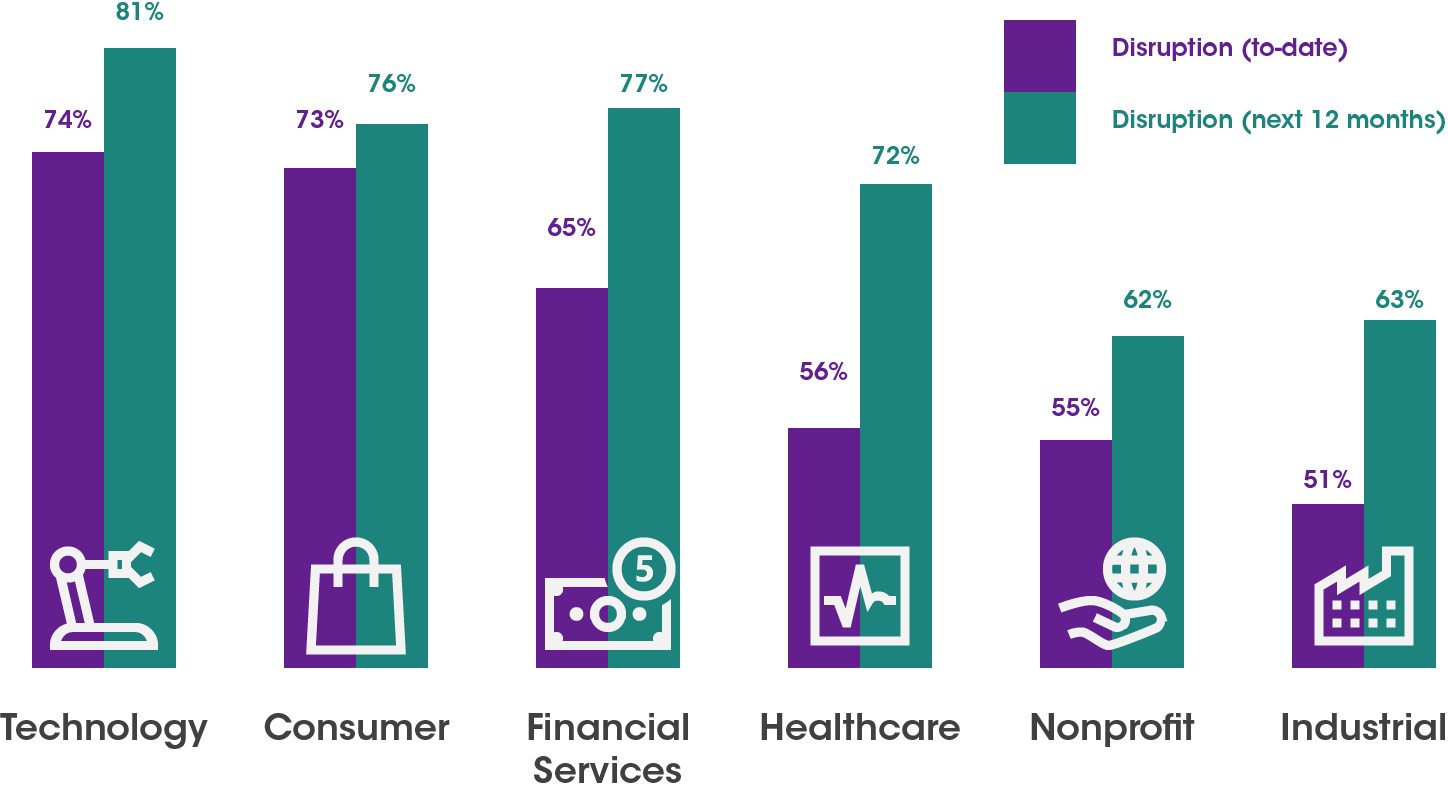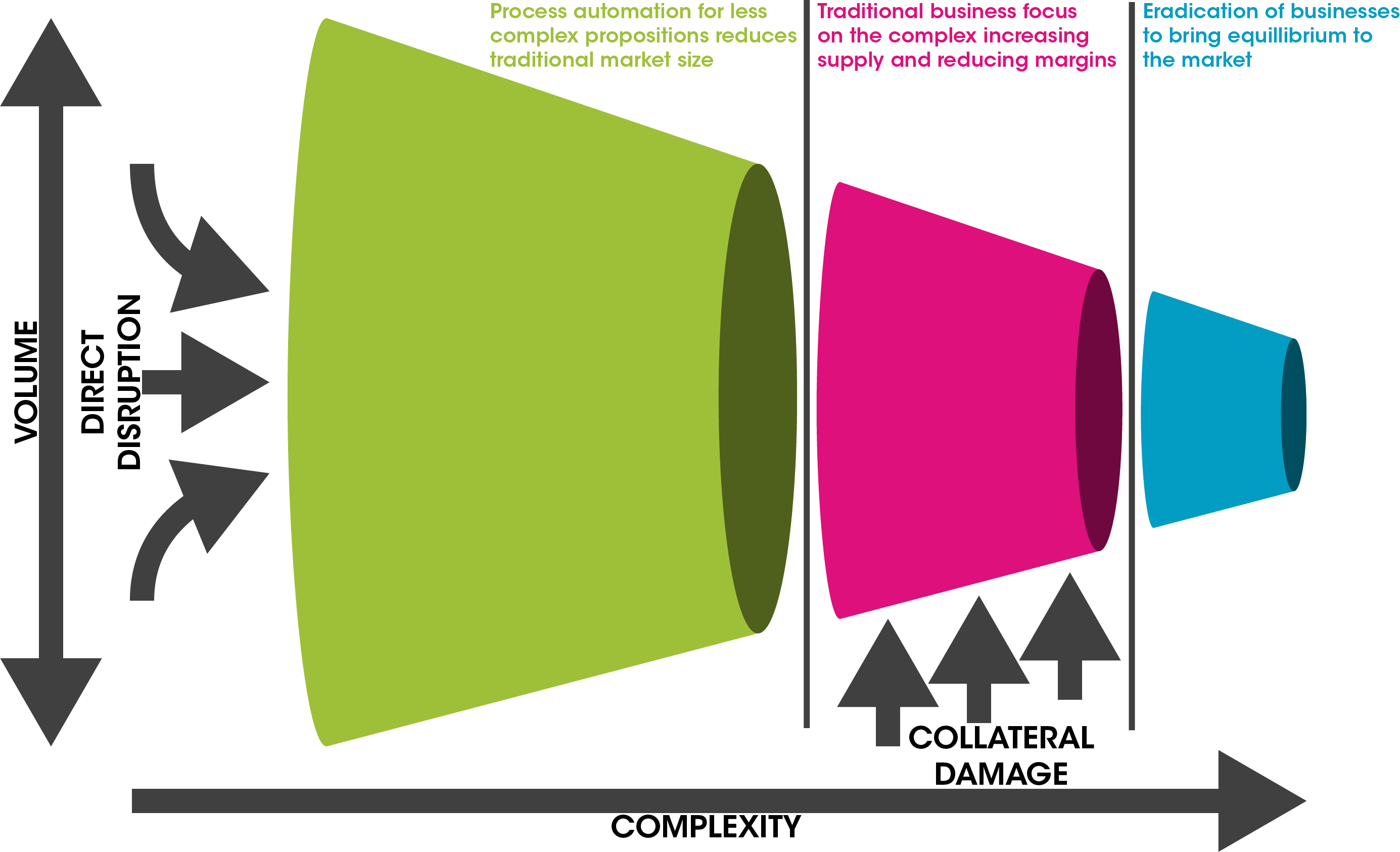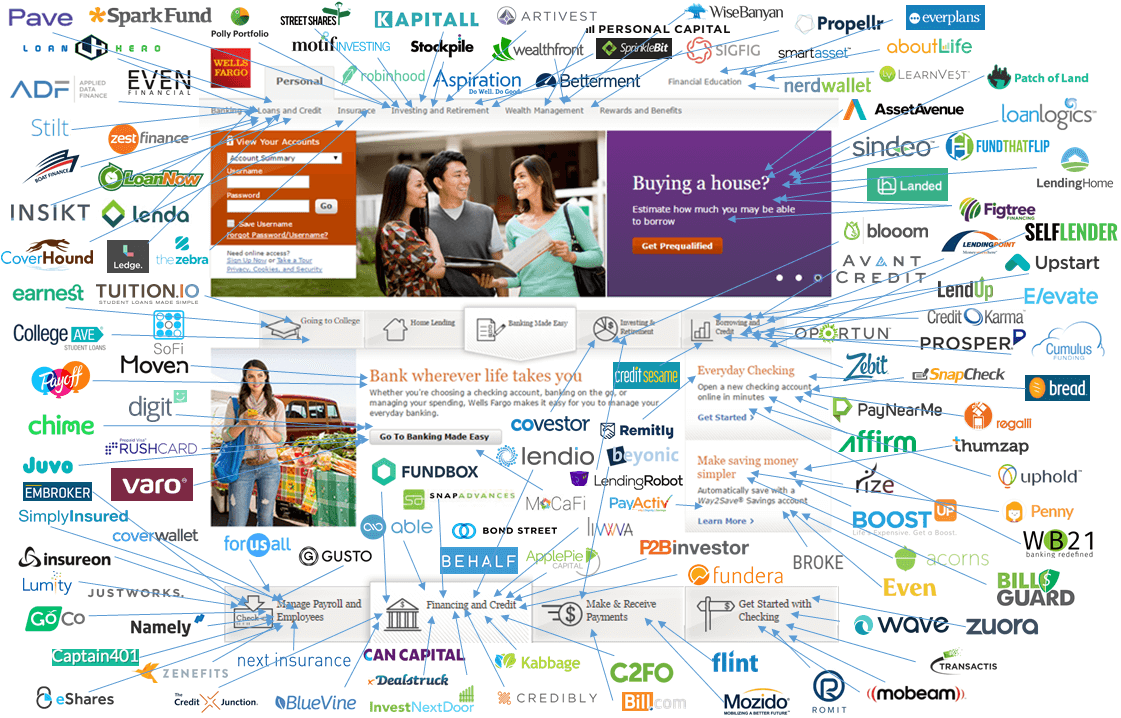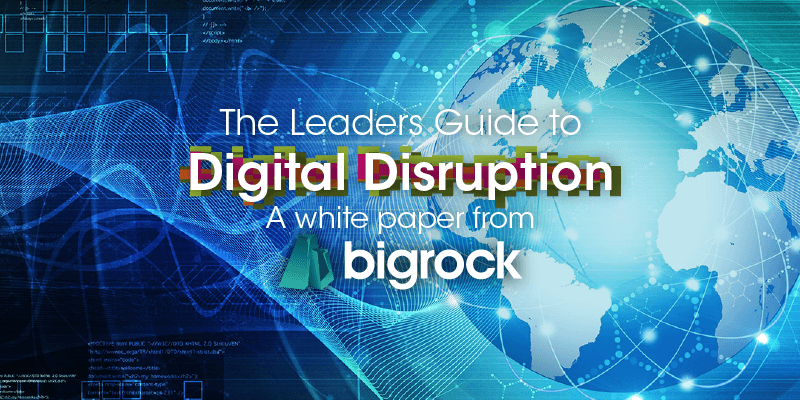Contents
“When people adopt technology, they do old things in new ways. When people internalise technology, they find new things to do.”
1) Introduction
Digital technologies are now an integral part of the way we live our lives, at home and at work. Yet, arguably, the digital revolution is just beginning. The potential for new digital technologies to transform the way we work and the way we live is vast. Just as in the 19th century the industrial revolution transformed businesses, cultures and politics, along with people’s everyday lives, so the digital revolution is set to transform our world.
Every day we speak to business leaders who recognise that their industry is either going through, or is on the cusp, of significant change spurred by the new opportunities and challenges presented by digital technologies. In every industry the existing norms, the very way people operate and do business, are being challenged. Existing business habitats are either disappearing or changing. Another term for this is digital disruption.

The Impact of Digital Disruption is Increasing Across all Industries: Data from Russell Reynolds Associates, Digital Pulse: 2017 Outlook & Perspectives from the Market, March 2017.
Don’t have time to read the whole white paper right now?
No worries. Let us send you a copy so you can read it when it’s convenient for you. Just let me know where to send it (just takes 5 seconds).
2) What is Disruption
First let’s begin by exploring what is meant by Disruption. Disruption is not new. The term ‘disruption’ became part of the business lexicon when Clayton Christensen introduced the idea of disruptive innovation in his 1997 book, The Innovator’s Dilemma.
In his book, Christensen used the term disruption to explain a style of innovation, typically used by new entrants to a market, in order to disrupt the old order and achieve success in a new way.
Established companies typically innovate by exploring how existing products can be enhanced or adapted to offer additional features that meet the needs of their most profitable customers. Their innovation is gradual and aimed at retaining their foothold in the market. They tend to focus on improving their products and services to meet the needs of their existing, most profitable, customers through ‘sustaining innovations’. For instance, a TV manufacturer hones their technology to create a clearer picture. It pleases their customers and gives them a competitive edge over other TV manufacturers. But it is not disruption.
Christensen identified that new entrants, or ‘disruptors’, who eventually rise to compete with or even displace established companies, begin from a different starting block.
Rather than trying to improve on what has gone before or what has worked in the past, disruptors look at how they could deliver value now, with the resources immediately available to them.
Disruptors are often start-ups or SMEs who are not incumbered by existing processes, large overheads, existing silos or past ways of operating. It is easier for them to think differently, to explore how problems can be solved in a new way, to rewrite the rules of the game.
Disruptors tend to enter the low-end of the market with products or services that are simpler, more convenient or cheaper than the established brands. The new entrant may only offer a handful of the features offered by a larger provider but they are, in some way, offering something new and/or more attractive to a specific segment of the market.
The existing players often do not see the disruptor as a threat. The disruptor is often serving a different customer who has different needs. The existing company’s customers consider the disruptor’s product or service as inferior.
However, where previously the existing players set the price, they are now being undercut by a disruptor who offers an alternative way to meet a need served by their product, often at a much-reduced cost. Initially, this may not matter. The disruptor is not (yet) taking the existing player’s market share.
For instance, in the world of automated financial advice, the automated bots are serving a customer who could not afford regulated financial advice from a traditional adviser. The bots simply act as a price comparison and don’t offer anywhere near the value of a meeting with a regulated adviser. Yet, as the automated service improves and the disruptor builds its brand, its service become more attractive to the adviser’s customers.
Faced with this type of competition from new entrants, traditional companies are forced to either find a way to lower their prices (and associated overheads, etc.) to compete with the disruptor, or offer additional benefits that drives their service further upmarket so that they are offering their customers even more.

Direct Disruption: Disruptive businesses typically begin by undercutting existing players through automation and new approaches that enable them to offer a cheaper alternative. Existing incumbents who can offer more complex services go up market. The market becomes smaller, as those who can’t compete with the disruptors or offer an improved service are forced out of the marketplace altogether.
Often the traditional companies cannot compete with the disruptor. Their existing processes, overheads and culture mean they cannot adjust to this new world. If they cannot find a way to move upmarket, then these companies can become collateral damage.
As the traditional companies look to move upmarket and offer extra benefits, this premium marketspace becomes overcrowded. There are only a certain number of customers who are able or prepared to pay more for a premium service that goes above and beyond what the disruptor will offer. In this overcrowded market, more companies will become collateral damage, until the market reaches equilibrium.
A disruptive business is likely to start by either satisfying less-demanding customers or by creating a market where none existed before. Only then do they move to threaten established markets. This does not necessarily happen quickly. When traditional customers begin to flock to the new entrant, then disruption has occurred.
For example, in 1997 when Netflix launched, Blockbuster, the established market leader in movie rentals, did not see Netflix as a threat. At that time, Netflix customers ordered movies through the company’s digital interface for delivery through the mail. Why would someone wait 2-3 days for a film, when they could pop down to their local Blockbuster and pick out one of the latest releases to watch that night?
Netflix did not appeal to Blockbuster’s core customer base. Not yet, at least. However, Netflix continued to innovate until new technologies enabled them to offer a service where customers could stream movies directly. Eventually, Netflix was able to undercut or surpass all Blockbusters’ main benefits.

3) What Makes Digital a Catalyst for Disruption?
There is nothing inherently digital about disruption. Yet, the coming of the digital age has made disruptive companies more common and has seen more established companies lose ground and even fail, when faced with disruptive innovation.
Why is this the case? What makes digital a catalyst for Disruption?
Non-digital or ‘analogue’ disruptive innovations take years of development and lots of investment before they can disrupt the old order and threaten existing incumbents. Analogue disruption needs to achieve scale in order to become profitable and sustainable. As such, only a few innovators have the time, resources and connections to set up their business, bring their offer to market and grow to threaten the old order.
This is not the case when disruptive innovation utilises digital technologies. Digital disruptors do not need the same level of investment, nor does it take the same amount of time, to test the validity of an idea. In an analogue world, the disruptor faced blockers at every turn from production, through to marketing and distribution. Now, friction free digital infrastructure is available to the smallest and largest of digital disruptors.
You can develop a digital product, with free or relatively cheap digital tools, with no more than a laptop. You can launch your product on Facebook and Twitter and begin selling through marketplaces like the App Store, eBay or Amazon, without a large marketing or distribution budget. In this way, digital is a great leveller.
Digital tools and infrastructure effectively destroys the traditional barriers to entry. Anyone with the right idea and the motivation to drive forward their idea, can now disrupt the largest companies.
Forget investment, all a digital disruptor really needs is a good idea and a disruptive mindset. Now more innovators have the opportunity to bring their big idea to market and make it a success. It is simply a numbers game. Digital tools mean that where previously 1 in 10 people with a good idea may have had the resources to bring that idea to life, now all these people can at least begin to develop their idea and create a business.
These free tools are available to all, to the established brands as much as the disruptors. However, disruptors tend to use these tools more. Whilst existing companies are looking at what they have done in the past and how they can enhance this, disruptors are looking for what they can do now and in the future, with the resources they can immediately access. It is a different mindset that makes a big difference.
An established organisation will have existing process, partners and suppliers, with whole teams set up to manage a particular form of distribution and a specific process for developing products.
Disruptors have none of this. They begin by looking at how they can solve a problem. They are naturally driven to the latest, cheapest and simplest resources available. They have no historic silos, processes or culture to hold them back.
Instead they have a digital mindset. The next generation of entrepreneurs have grown up in a world where, just as you no longer need a recording contract to create a hit record, you no longer need a large sales and marketing team to reach customers. They have grown up in a world where you are always a simple search away from a tool that can meet your need and solve your problem… and often this tool is free.
In the world of social media, the new norm is to share. The next generation of disruptors will be far more collaborative and open. Increasingly, business is not conducted behind closed doors, but across continents. Those with a digital mindset can collaborate globally with other small businesses across the world.
Established firms in industries like financial services, insurance, professional services and commercial real estate may argue that their industries are complicated and the range of products and services they offer mean that a disruptor could never develop far enough to compete. They may be right… one disruptor may not be able to. Yet together, new entrants can challenge the big organisations. Figure 3, right, shows a range of companies that all offer an element of a service or product offered by a large bank. Individually they can’t compete with the incumbent, but as a collective (whether officially collaborating or selected by the customer) they can.

4) An Example – Lemonade Insurance
Lemonade is a new US-based insurer that works in a completely different way to most insurers. The founders have combined digital technology and artificial intelligence with a mindset that puts the customer’s priorities at the heart of what they do. In doing so, they have created a business with the potential to be highly disruptive.
As many of our readers will be aware, traditional insurance companies make money by keeping the money they don’t pay out in claims. If their customers need to make a claim, the company effectively loses some of their profits. Lemonade doesn’t work like this. Instead they take a fixed fee out of the customer’s monthly payments, to cover their costs, reinsurance, other expenses and their profit. The rest goes in a pot for playing claims. Any money that is left over from this pot is donated to charitable causes chosen by their customers. In doing so, they have removed the perceived conflict of interest whereby a traditional insurance company loses out when it pays claims, when their customers need them the most. As such, Lemonade have a unique proposition, that is in tune with the digital mindset of transparency and sharing.
If this business model wasn’t disruptive enough, Lemonade have combine it with automated bots and easy to use apps that enable them to pay claims at an astonishing speed. It takes just 90 seconds to get insured with Lemonade and just 3 minutes to get paid on a claim.
In a recent article in BankingTech, Daniel Schreiber, co-founder and CEO of Lemonade, explained;
“One of the factors that stood out most to Shai [Wininger, Lemonade’s co-founder] and I when building Lemonade was the lack of transparency and conflicted interests. It was mind boggling that an industry that is performing such an important societal role, is perceived so negatively. Insurance fraud is a serious symptom of this. That’s why we made transparency, and overcoming conflicts of interest a significant pillar of Lemonade.
“Both Shai and I are veterans of the tech ecosystem and knew nothing about insurance when we first started. It’s precisely that outlier, tech-focused perspective that we brought to the insurance industry. It’s extremely difficult to change foundations from within an organization or an industry.
“When you know too much about a certain subject, that can bind your imagination and cap your creativity. It restrains you from taking that impossible route. So if you’re looking to change or evolve your own organisation, I’d say: get an outsider’s perspective. Think big, and don’t let any conventional wisdom tie you down.
“We view Lemonade as a tech company doing insurance, and not the other way around. This mindset allows us to iterate fast. Our engineers can code algorithms into our app on the go, our product managers can design features overnight. It’s precisely this agility that the incumbents struggle with.”
Above, Schreiber demonstrates some of the key traits of a disruptor. He has approached the world of insurance from a completely different perspective and entered from a different market (technology). He doesn’t ask ‘how can we change the existing industry?’. Instead he says this problem can now be solved like this… catch up if you can. Lemonade haven’t simply automated insurance, they have thought differently about what insurance is and the value it delivers for customers.
5) Responding to the Digital Disruption Threat
Predicting when, how and from where you may be disrupted is not a simple task. Some may say trying to predict the next disruption is not even that helpful. Disruptive businesses often originate from a different industry to the one they end up disrupting. Sometimes it can be something completely new. We are not talking about your existing competition. Next year you could be pitching against a provider from a completely different background and industry, who have found a new way to approach your customer’s needs. Or, more likely, you won’t be pitching at all, as the disruptor will sell in a completely different way. Not only will they disrupt your product or service, but also your sales and distribution model.

Rather than trying to anticipate who your future disruptors will be, it is much better to embrace the disruptive mindset and develop an organisational culture that is receptive to digitally disruptive ideas.
Often the best innovations come from the largest organisations. They often have the brightest thinkers and the best resources. They know the marketplace best and are attuned to customer needs and challenges.
The problem is existing companies are not always able to develop new ideas and often do not recognise or value the disruptive innovations in the early stages of development.
Often new technologies are too new and weak for an existing firm to bring to market. The existing firm realises that their current way of operating delivers a better service for customers and so fail to develop the innovation to its full potential. Developing the new idea will take too long. If they do develop the idea, it may disrupt an existing successful product, that is currently doing very well. ‘Why undercut our own product?’
Existing companies are driven by the need for results. They need to demonstrate to investors, shareholders and customers that the latest product is better than the last, is more profitable… and that no money is being wasted. This focus on the customer and on results (generally a good thing in business) does mean that it can be difficult for leaders and managers to consider innovations that take the firm outside its usual processes and silos. Even if a leader is pushing to break down these silos, it can be difficult to disrupt the existing social norms to enable a new way of working.
In contrast, new entrants can be more flexible with their time. They do not have the overheads and existing processes that drive the bigger firm’s thirst for immediate results. Plus, they are naturally driven towards the free tools that enable them to develop, reject, innovate and re-develop their product repeatedly at low cost, until they do have something that will appeal to customers and challenge the incumbent.
Often these new disruptive firms are founded by the frustrated ex-employees of the larger firms who refused to continue developing their new idea. The democratisation of business that digital brings (discussed in section 4) means that employees really do have the choice, in a way they haven’t had before, to go in to business for themselves. It’s still a risk and will be too risky for many, but it is a much more realistic and viable option than ever before.
If larger businesses can instead nurture a culture that welcomes disruptive ideas and enables employees to develop them alongside existing products and services, then not only will these firms compete with the disruptors they will also retain and attract top innovative talent. ’Ideas people’ will seek the opportunity to work with these firms that can offer both job security and the chance to be at the forefront of innovation.
6) Creating a Digitally Disruptive Culture
So how can you, as a leader, prepare you firm to survive and thrive in the new digital world? How can you stay ahead of the disruptors, whilst continuing to delight your customers and achieve results?
Firstly, ensure you react but don’t overreact. If you are leading a successful business you are already in a very strong position. Make sure you continue to strengthen this core business, whilst clearing the path for disruptive ideas. Build on your relationships with your core customers, gain a deeper and broader understanding of their needs. Nurture sustaining innovations that make your existing products and services better. Your next new disruptive idea may not come over night and may not be an immediate success. It is important that you stay successful and retain your customer base, whilst giving disruptive ideas the time to develop. This is likely to mean juggling two different business operations at once.
Leaders need to nurture a digitally disruptive culture, without undermining current success. In his book, Digital Disruption: Unleashing the Next Wave of Innovation, James McQuivey suggests a three-step process for doing just that.

Three-step process to nurture a digital disruptive culture: Use these 3 steps to prepare your organisation to survive and thrive in the world of digital disruption.
6.A) Adopt a Digital Disruptors Mindset
Digital disruptors think about opportunities differently. They have a ‘let’s try it’ mindset.
The low cost and rapid development possible using digital tools mean that disruptors are now developing ideas that in the past would have been dismissed as completely unfeasible, both for a start-up and for a big organisation.
You and your organisation need to embrace this same mindset. You need to be open to new ideas, to new innovations and to new ways of operating. As a leader, you need to role model this mentality. Your team will take their lead from you. If you are open to new ideas and encouraging disruptive innovations your people will begin to consider new ideas, develop their thinking and bring you innovations.
In an interview on digital transformation, Professor Tyler Rye (of the Wharton School, University of Pennsylvania) explained the important role the leader plays nurturing the right organisational mindset:
“Obviously, in an organization, the leader is going to be the person who guides the organization through any transformation, and if the leader hasn’t transformed the way they look at the world, it’s going to be really hard to credibly lead these changes, or to even understand what these changes need to look like. This involves being open to change, being receptive to new ways of learning, being willing to butt up against areas where you don’t know things — and then not react out of fear or feel threatened as the person in the room who knows the most. … If you aren’t engaging with the right information and you’re not open to transforming yourself, it’s going to be hard to drive these changes through the organization.”
6.B) Behave Like a Digital Disruptor
Once you have the mindset of a digital disruptor, the next step is to behave like a disruptor. Whilst new behaviours will, to some extent, be a natural result of your new mindset, it is important for leaders to ensure new beliefs translate in to a new approach.
It will be impossible for a large organisation to behave like a start-up disruptor in every way, nor should it. After all, as well as experimenting with disruptive innovations, a large organisation also needs to serve customers today and nurture sustaining innovations to its existing products and services in order to stay competitive with its traditional market rivals. However, there are some key traits your organisation can adopt.
Ask the right questions:
As we have explored, one of the advantages that digital disruptors have is a fresh perspective. They often approach your customers’ needs from a completely new angle. To compete, your people need to think differently too.
When exploring ways that you can innovate, think about how your customers currently experience your products or services. What needs are you addressing?
Make a list of these needs and any other needs your customers have that you could meet. Consider how these needs are met by other products and other industries. If your customer couldn’t get your product from you or your direct competition, where might they turn? How else could their need be met? Don’t be distracted by past approaches. This is about looking beyond how you currently serve customers.
Don’t ask ‘What’s the next step for our product?’ Instead, ask ‘What’s the next thing our customers need?’
Don’t jump too far:
Whilst disruptive innovation is not about gradually developing your existing product, it is also not about jumping in to something entirely new. You still need to play to your strengths and compete where you have something valuable to add.
When the Lemonade founders entered the insurance industry, they didn’t have any financial services experience. However, they knew that their expertise with bots and artificial intelligence meant that they had something to offer in this market.
When considering an innovative idea, begin by exploring how it can meet customer needs and the added value it can deliver for customers, but then consider how easily and elegantly your organisation can deliver this idea and offer these benefits. If you can’t deliver it easily, with your existing resources, it may not be worth pursuing.
Disruptors use their expertise to approach new ideas and create new products that threaten different industries. If a new idea takes you outside of your area of expertise, then you are not behaving like a disruptor in pursuing it.
This doesn’t mean saying no to an idea. Just make sure you prioritise the easiest ideas. If there is an idea that has the potential to delight your customers that you can develop quickly and easily – start there. Keep other ideas as a list, and come back to them later.
Use the digital tools & welcome digital partners:
Look for and use the free tools and digital infrastructure that the disruptors are using. Encouraging disruptive innovations should not require significant budget. The reason the digital disruptors are such a threat to you is because they don’t require significant investment in order to succeed. Well, neither do you.
Encourage your people to explore the web, find free tools, enter the sharing economy and discover what they can create with what’s out there. Digital platforms offer unprecedented opportunities if you use them to build digital bridges to your customers, measure early and often and adapt quickly based on feedback.
Break down silos; within your organisation, with your external partners and with the wider world. Find ways to allow your people to discuss ideas openly, draw on the talents of others and gain immediate feedback from their peers and from customers.
This will enable your people to develop, test and refine new ideas as quickly as, or quicker than, the disruptors do. Plus, you can combine these free tools with the extensive resources available to a larger company (tools the start-ups can only dream off).
However, the important thing is to retain that digitally disruptive mindset; to look for new ways of working, to ask the right questions and to take your place in the new world created by digital. The tools are simply that… tools.
“If you look at digital transformation, there are many technological elements that can be dubbed as digital, but that doesn’t make an enterprise a digital enterprise just because you’re using those technological elements. They are enablers, but you really need to embrace the culture, the mindset and how you approach the business, of a digital enterprise. When we analysed digital enterprises, two qualities stood out: one is continuance innovation or a culture of experimentation, and second was speed. Everything was done at five times, 10 times, 50 times the speed. These two attributes — and having the right culture and those technological elements — make a digital enterprise.”

Accept & expect Failure:
In order to develop new ideas, people need to be allowed to fail. The next great idea will not come over night. Your innovators will need the freedom to try, test and fail with tens, perhaps hundreds of ideas, before they find and fully refine an idea that will change the shape of your industry. This is true for your people as much as it is true for small start-ups.
Keep innovation projects small and flexible. Allow teams to bounce between ideas and pursue multiple options. This is not about one big 5-year innovation strategy.19 This is about giving your people the freedom to have an idea, experiment and see if it works. If it doesn’t work, you won’t have invested much, your business will have learnt something and the innovator will have had chance to try their idea and grow within your business. If it does work, your organisation has a great new product or service to take to customers.
6.C) Disrupt Yourself Now
Even if digital disruption has not had a significant impact on your industry yet, you need to begin making changes and looking for innovations now.
Establish digital disruption as a c-suite level priority. This needs to be driven from the top of your business, by all your leaders. Then communicate your vision for digital transformation to the wider organisation.
In order to be a truly digital business, everyone in your organisation needs to have a digitally disruptive mindset. This is not just about product innovation. It is about how you sell, how you market, how you accept payment and how you attract talent. It’s about every aspect of your business operations, as all of these could be disrupted.
Then encourage teams to think innovatively and present disruptive ideas. Welcome all innovations and select a few to move forward with. Ensure senior leaders commit their support, that teams are given time to develop their ideas but work to short development timeframes. In short, work like a disruptor.
“The wave is coming, there is no getting out of the way. Either you decide to surf it and go on that terrifying but thrilling trip as the wave pushes you — or get crushed by it. There really is no other option.”
Bigrock Support with Digital Disruption
Bigrock can design and deliver bespoke events, seminars and workshops for leaders, to introduce the concept of digital disruption and explore ways your organisation can create a culture that drives disruptive innovation within your business.
We can also work with you to help you transform your business, drive cultural change and develop an innovative mindset across your organisation.
If you would to discuss digital disruption, the impact it may have on your business and how you can prepare with one of our experts, please call +44 (0)1280 820 780 or email enquiries@bigrockhq.com to arrange a consultation.
Subscribe below to receive our latest insights direct to your mailbox.
Bibliography
CBInsights, ‘Disrupting Banking: The Fintech Startups That Are Unbundling Wells Fargo, Citi and Bank of America’, November, 2016. https://www.cbinsights.com/research/disrupting-banking-fintech-startups (Accessed 28th July 2017).
‘Digital Disruption: What Is It and How Does It Impact Businesses?’, Oxford College of Marketing Blog Post, http://blog.oxfordcollegeofmarketing.com/2016/02/22/what-is-digital-disruption/ (Accessed 25th May 2017).
Christensen, Clayton M, Raynor, Michael E. and McDonald, Rory ‘What is Disruptive Innovation’ in Harvard Business Review, December 2015. https://hbr.org/2015/12/what-is-disruptive-innovation (Accessed 2nd June 2017).
McKendrick, Joe ‘7 Emerging Truths Of Digital Disruption’, in Forbes, 21 Feb 2017, https://www.forbes.com/sites/joemckendrick/2017/02/21/7-emerging-truths-of-digital-disruption/#608b02c629a6 (Accessed 25th May 2017).
McQuivey, James Digital Disruption: Unleashing the Next Wave of Innovation, Las Vegas, 2013.
Merrins, Oisin editor at InsurTech Rising, Interview: Daniel Schreiber, co-founder and CEO of Lemonade, 5 June, 2017 in BankingTech, http://www.bankingtech.com/851111/interview-daniel-schreiber-co-founder-and-ceo-of-lemonade/ (accessed 12/6/2017).
Russel Reynolds Associates, Digital Pulse: 2017 Outlook & Perspective from the Market, March 2017. (Downloaded from http://www.russellreynolds.com/insights/thought-leadership/digital-pulse-2017-outlook-perspectives-from-the-market ). ”
Team Tony, ‘What Disruption Really Means, Tony Robbins https://www.tonyrobbins.com/career-business/what-disruption-really-means/ (Accessed 2nd June 2017)
‘The Digital Leader: Self-transformation for Long-term Success.’ Knowledge@Wharton. The Wharton School, University of Pennsylvania, 30 November, 2016. http://knowledge.wharton.upenn.edu/article/digital-leader-self-transformation-long-term-success/. (Accessed 2nd June, 2017).
Thrasyvoulou, Xenios ‘Understanding the Innovator’s Dilemma’, Wired, https://www.wired.com/insights/2014/12/understanding-the-innovators-dilemma/. (Accessed 2nd June 2017).
We would also like to thank Mark Steers for his input and support in the development of our thinking around digital disruption and its impact on business, and the world of financial services in particular.
